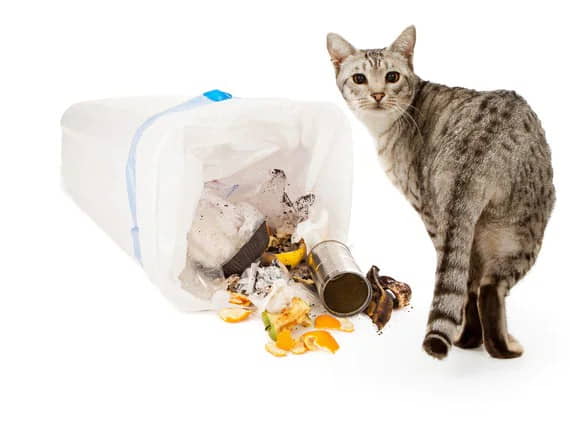Jacque Lynn Schultz, C.P.D.T., Companion Animal Programs Adviser. National Outreach
By tooth and nail, indoor cats can cause tremendous household destruction. Some cats nosh on house plants and eat inappropriate materials such as dirt, leather and wool – a habit referred to as pica. Others resort to that old feline classic – using the furniture as a scratching post and the curtains as a jungle gym. Feline destruction can be handled by managing the problem, offering the cat more palatable options, and making former choices less rewarding. A combination of all three will solve most problems.

Taking the Bite Out
The first step in dealing with pica is a veterinary exam to rule out a physical problem such as a metabolic imbalance. After getting the go-ahead from your veterinarian, consider the following options for plant protection:
- Hang tabletop plants or put them in an off-limits solarium.
- Spray leaves with an anti-chew agent for plants, and attach balloons or double-stick tape to planters. A good choice is near a cat’s favorite napping place, as the urge to scratch is often strongest upon awakening.
- Satisfy your kitty’s craving for fresh vegetation by making flats of catnip and wheat grass available to him/her.

The first line of defense with a cat who eats or chews non-plant items is to keep these objects in drawers, closets or closed containers. Distract the cat with plenty of his / her own playthings. Chewing inappropriate items may signal boredom and isolation, so try to increase exercise sessions and rotate toys every few days. Introducing a second cat as a playmate might also alleviate this problem, but this is only an option if you truly want a second cat. Bringing additional cats into a household can initially stress the existing occupant, and fighting, inappropriate litter box habits, nocturnal behaviors and even stress-related health disorders such as Feline Lower Urinary Tract Disease can result.
You can also try combating pica by attempting to retrain the cat through dietary measures. Feed a premium-quality dry food with adequate fiber or a raw diet, and no other supplements or treats. At the same time, remove the former pseudo-food items for at least two weeks. After the requisite time period, douse the items with an anti-chew spray and reintroduce.
Surviving without a Scratch
To deal with the No. 1 destruction complaint, furniture scratching, choose furnishings and drapes that are tactilely unattractive to cats. Most smooth cottons (chintz) or silky parachute cloth don’t interest felines, who prefer rough, bumpy Haitian cloth, Herculon, raw silk and leather. If the furniture pre-dates the cat, you can protect it with a sheet, comforter or the dreaded plastic slipcover. You can also retrain the cat by covering favorite targets with double-stick tape, balloons, tin foil, contact paper (sticky side up) or perhaps a commercial product like Sticky Paws™.

Cats inherently need to scratch in order to remove dead nail sheaths from around their sharp new claws. Trim the cat’s nails every two weeks to keep them blunt, and provide a suitable scratching post.
- Install a sturdy, wide-based post at least three-feet tall covered in sisal, coiled rope or similar rough-textured fabrics. A natural (but de-bugged) tree trunk is another option.
- Initially set the post beside the inappropriately scratched item, and then gradually move it to a preferred location. Cats avoid sites of loud noises (popped balloons) or surfaces that are tacky to the touch.
- Entice your cat to the post by running your nails over it (and praise the cat when he or she responds), or dragging a ribbon or other interactive toy over or near the blog post.
- Several times a month, sprinkle potent catnip on the post if your cat responds favorably to this herb.
There is no doubt that by providing for a cat’s physical and mental needs in a stimulating environment, much of the destruction typically caused by tooth and nail can be avoided.
Wondering about Marking? Check it out on our latest post!


0 Comments